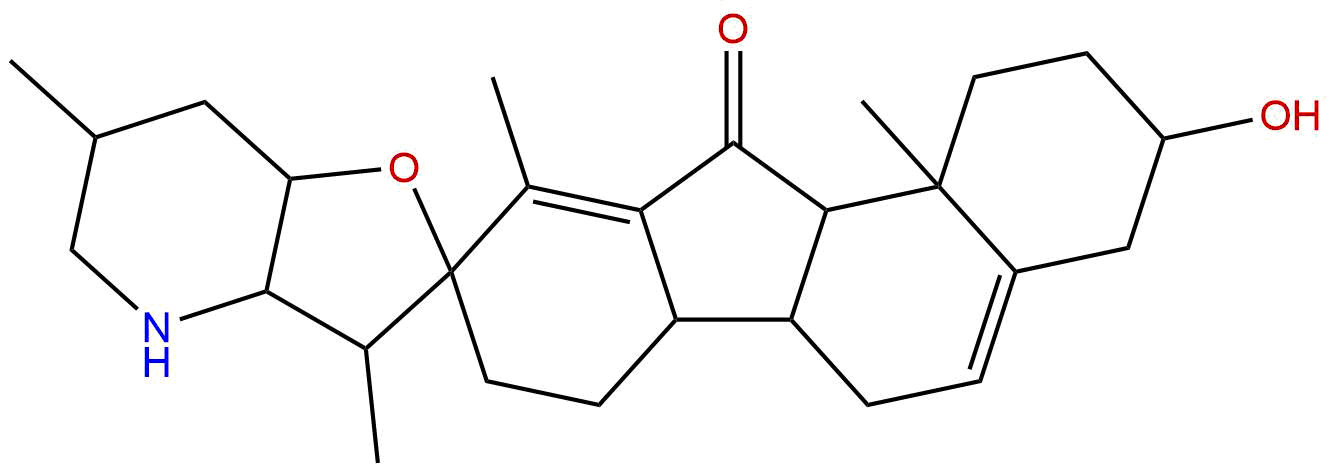
JervineCAS No.:469-59-0 |
||||||||||
 |
|
|
||||||||

| Catalogue No.: | BP0810 |
| Formula: | C27H39NO3 |
| Mol Weight: | 425.613 |
| Botanical Source: | Veratrum nigrum L. |
Product name: Jervine
Synonym name: 17,23-Epoxy-3-hydroxyveratraman-11-one; Jervin-11-one
Catalogue No.: BP0810
Cas No.: 469-59-0
Formula: C27H39NO3
Mol Weight: 425.613
Botanical Source: Veratrum nigrum L.
Physical Description:
Type of Compound: Alkaloids
Purity: 95%~99%
Analysis Method: HPLC-DAD or/and HPLC-ELSD
Identification Method: Mass, NMR
Packing: Brown vial or HDPE plastic bottle
Storage: Store in a well closed container, protected from air and light. Put into refrigerate or freeze for long term storage.
The product could be supplied from milligrams to grams
Inquire for bulk scale.
Description:
Jervine exhibits cytotoxic activity against human tumor cell lines A549, PANC-1, SW1990 and NCI-H249, it induces COX-2 overexpression in human erythroleukemia cells. Jervine exhibits potent toxic effects against Colorado potato beetle.
References:
Phytother Res. 2010 Jun;24(6):821-6.
Antitumor and antiplatelet activity of alkaloids from veratrum dahuricum.
CONCLUSIONS:
Ten steroidal alkaloids - cyclopamine, veratramine, Jervine, 3, 15-diangyloylgermine, 3-angyloylzygadenine, 3-veratroyl zygadenine, 15-veratroylgermine, germine, veratrosine and pseudoJervine - from Veratrum dahuricum, together with the ethanol extract and total alkaloids, were evaluated for their antitumor and antiplatelet activities. Cyclopamine, veratramine and germine significantly inhibited the hedgehog pathway in NIH/3T3 cells. Cyclopamine exerted a potent inhibitory effect against the growth of PANC-1 tumors in mice, with inhibition rates of 40.64%, 44.37%, 46.77% at doses of 5.0, 15.0 and 50.0 mg kg-1, respectively.
CONCLUSIONS:
Veratroylgermine was found to produce the strongest inhibition against the platelet aggregation induced by arachidonic acid, with inhibition rate of 92.0% at 100 microM.
Exp Cell Res. 2013 Apr 15;319(7):1043-53.
Cyclopamine and jervine induce COX-2 overexpression in human erythroleukemia cells but only cyclopamine has a pro-apoptotic effect.
Erythroleukemia is generally associated with a very poor response and survival to current available therapeutic agents. Cyclooxygenase-2 (COX-2) has been described to play a crucial role in the proliferation and differentiation of leukemia cells, this enzyme seems to play an important role in chemoresistance in different cancer types. Previously, we demonstrated that diosgenin, a plant steroid, induced apoptosis in HEL cells with concomitant COX-2 overexpression.
METHODS AND RESULTS:
In this study, we investigated the antiproliferative and apoptotic effects of cyclopamine and Jervine, two steroidal alkaloids with similar structures, on HEL and TF1a human erythroleukemia cell lines and, for the first time, their effect on COX-2 expression. Cyclopamine, but not Jervine, inhibited cell proliferation and induced apoptosis in these cells. Both compounds induced COX-2 overexpression which was responsible for apoptosis resistance. In Jervine-treated cells, COX-2 overexpression was NF-κB dependent. Inhibition of NF-κB reduced COX-2 overexpression and induced apoptosis. In addition, cyclopamine induced apoptosis and COX-2 overexpression via PKC activation. Inhibition of the PKC pathway reduced both apoptosis and COX-2 overexpression in both cell lines. Furthermore, we demonstrated that the p38/COX-2 pathway was involved in resistance to cyclopamine-induced apoptosis since p38 inhibition reduced COX-2 overexpression and increased apoptosis in both cell lines.